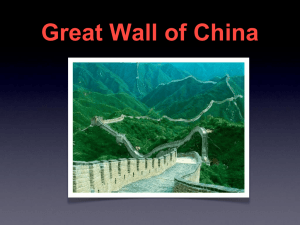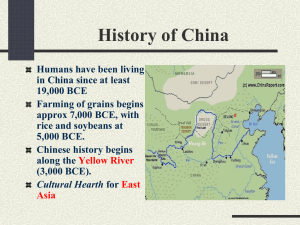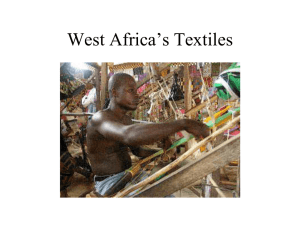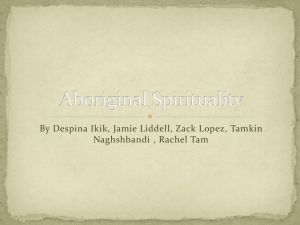LINK IS HERE: Non Western Art Powerpoint
advertisement
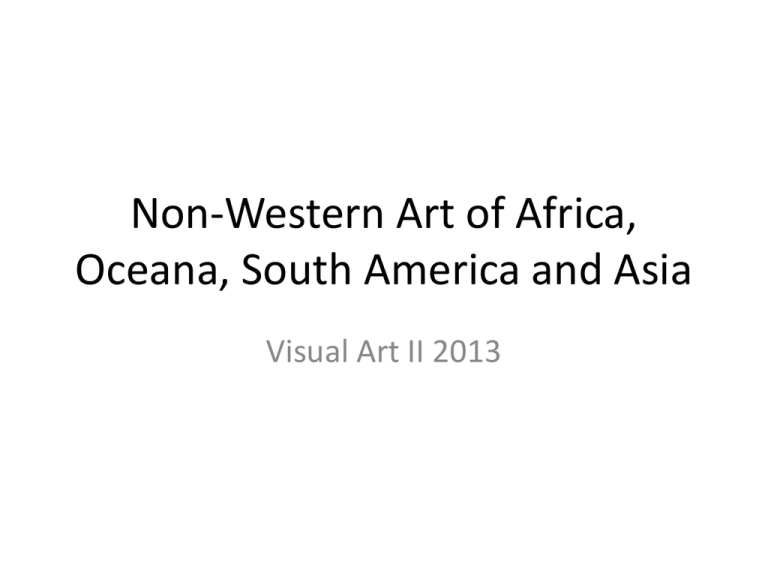
Non-Western Art of Africa, Oceana, South America and Asia Visual Art II 2013 Western vs. Non-western • • Both images depict a portrait of a Maori chieftain, one by the chieftain himself (left) and one by a European artist (right). Both show his facial tattoos, however the European artist, John Sylvester, shows the head and shoulders and downplays the graphic elements of the tattoos. He also portrays the king as an English gentleman with western style clothes and hair style. The chieftain, Te Pehi Kupe, chose to highlight the stark shapes and design of the tattoos while undermining the human features. In his self-portrait, the King portrays himself in a more basic form and less linked to the westernized culture. Western vs. Non-western Western Regions • Europe – – – – England France Germany Spain • North America – United States – Canada Non-western Regions • Middle East – Isreal – Iraq – Afghanistan • Africa • Australia (aboriginal), New Zealand • South America • Asia African Art African Art: Kente • Kente is one of many original fabric designs created by African artists. • Fabric is an important part of African culture because clothing can express social status, ethnic identity. Colors are also used to tell stories and represent spiritual symbols. • Kente originated in Ghana in the twelfth century, and was worn by kinds queens and important figures during ceremonial events. • Today Kente is often worn in the US to represent African-American heritage and it is printed worldwide. African Art: Kente One of many unique Kente cloth designs Ashanti king in Kente cloth African Art: Adire • Adire fabric was originally made by the Yoruba women in Nigeria. • Adire patterns are characterized by squared grids, with solid, flat, organic shapes. African Art: Mud Cloth • Unlike royal Kente cloth mud cloth designs were originally created by poor, rural craftsmen in Mali. • Mud cloth is now considered a symbol of national identity for Mali. • The fabric is called mud cloth because patterns were originally made by painting cloth with iron rich mud. African Art: Mud Cloth African Art: Bamileke • The Bamileke people immortalize images of Africa’s past through their ceremonial art and masks. • In traditional ceremonies a dancer wears an elephant mask to symbolize strength and energy. • Beaded Bamileke animal masks are stylized but maintain organic natural forms. African Art: Bamileke African Influence • Faith Ringgold is an African-American artist who’s art is heavily influenced by African art and fabrics. They share as stylized form and medium. Like a lot of African art, her quits tell stories through images. Aboriginal Art Aboriginal Art • Aborigines are the native people of Australia. • Their art is characterized by interlocking shapes and stylized images. • Aboriginal art is very different from western art styles. It involves different perspectives, shapes, and methods. • Despite European settlement in the region, Aboriginal art has survived into modern times. Aboriginal Art: Natural Mediums Natural pigments used to dye and paint natural surfaces Aboriginal Art: Patterns • Aboriginal art of ten is characterized by earth tones, images shown from above or in profile, and simple organic shapes. • They also often involve repeated patterns, with concentric circles and horizontal lines. These patterns represent different symbols of the aboriginal culture and history. • Images are often hidden within the seemingly simple shapes. Aboriginal Art: Patterns Aboriginal Art: X-Ray Style • X-Ray style of Aboriginal art was developed to show the every aspect of the artist subject. In addition to outlining the basic shape inner parts of animals and people may also be included in the image. Aboriginal Art: Journeys • Aboriginal Art often depicts a journey or acts as a sort of map. • Multiple focal points, and overhead point of view are used to act as a guide. Aboriginal Influence • Keith Haring is an American artist that was heavily influenced by Aboriginal art. His work uses similar shapes and repeated patterns to create symbolic images. Chinese Art Chinese Art • Chinese art is one of the oldest and most unique types of non-western art. Its influence has been shown throughout many centuries around the world. • Sculpture was the earliest of the Chinese art forms, however, during the Han dynasty when paper was invented paining became more prominent. • During the early Tang dynasty paintings were mostly lifelike, realistic, detailed figures depicting royal life in what was called court style Chinese Art: Court Style Chinese Portraits during the Court Style period in art – Ching Dynasty Only the members of the court were In this manner, Emphasis was on Attempting to create a likeness so The people viewing the image would Know it was the emporer Althoug the emporer sat in front of The artist – Artists did not yet know how to use Perspective, anatomy, foreshortening, Chiaroscuro, The figure is seen here as all important As the background is a flat gold color Artist unknown DateMiddle Ages in Europe Western Portaiture 1504-1912 Mona Lisa by Da Vinci- 1503- 1506 Drawn from life Atmostpheric or aerial perspective Chiaroscuro Knowledge of Anatomy Sfumato- blurring of edges so that the eyes, nose, mouth And hands are in focus but as you go Back in space the figure is softer – hence further Away The background is imaginary and does not Match from the left to right side Oil on Panel Western Portraiture Hans Holbein Henry the VIII Oil on Panel Baroque pd in Art – What are at least four characterics that follow The traditions of Western Art ? Chinese Art: Subject Matter • By the end of the Tang Dynasty the subject matter of most Chinese paintings had been narrowed to three main groups: figure, landscape, and bird/flower paintings. Scholar painting in Chinese Art during the Yuan to Ming Dynasty • Time frame is Yuan-1279-1368 • Ming Dynasty- 1368-1644 These are sections From handscrolls Assymetrical Ink and Color No reference to Background- flat Lack of proportion A Horse and Groom in Red Coat – Yuan Dynasty Chinese Landscape Yuan and Tang Dynasties Lotus Pond and Waterfowl Lotus represents hope and purity Cranes symbolize good luck and long life This painting is stylized ( abstracted ) and the background Is flat Hanging scroll ink and color Chinese painting Ching dynasty Chinese painters prefer to capture The ESSENCE of a subject so many Details are left out They work from memory and Enjoy the concept of uncluttered Space A well ordered garden symbolizes Harmony in the universe Certain plants symbolize virtues Western Images of Nature: What are the characteristics that make this a Western work of Art? Albrecht Durer The Great Piece of Turf Watercolor Northern Renaissance Observation Realism Lighting 1503 Western VS Non Western Spring Morning in the Han Palace Ming Dynasty-1494- 1552 What is important to the artist? What is meant by hierarchical perspective? Is there a light source, use of proportion, anatomy, or one point perspective? This is painted on a scroll that unrolls to show each scene. What is the story Behind this painting? Court life and every day activities . Interior Northern Renaissance Northern Renaissance Interior Painting • http://www.chinaonlinemuseum.com/paintin g-qiu-ying-han-palace.php • Spring Morning in the Han Palace- Ming Dynasty • - 1494-1552 • ( Same time frame and the Italian Renaissance) Chinese Art: Natural Influence • Later, Chinese Art was more centrally focused on landscape as a subject matter. • The popularity of vast landscapes came about after the Tang Dynasty with the rise of Daoism. Daoism considers humans to be a small part in the workings of a complex and interactive natural world. • These Dao influenced paintings are characterized by intricate and large elements of nature, small figures, open negative space, and flowing movement. • Figures are often still a part of these paintings but are fairly small and insignificant to highlight that humans are a small part of a vast and ever-changing universe; Chinese Art: Natural Influence Chinese Art: Trends • Chinese painting is fairly stylized in that most paintings include vertical format, negative space, repeated curves, eye-level point of view, few lines and limited color schemes. • These similarities give Chinese art a unique look that has survived through ancient times into the modern art world and characterized a staple in Chinese culture. Chinese Influence • Huang Yan paints faces in the style of ancient Chinese paintings. The work contains the traditional linear landscape elements in a contemporary medium. Stop -End of Study Part I for test • The test for VA II will Part I on April 26 B day and April 29 A day • Africa • Aborigine • China • Western Culture- Characteristics of vs non Western culture of the above Islamic Art Islamic Art • Islam is not only a religion, but a way of life. Nearly one in every four people in the world is Muslim. Almost every work of a traditional Muslim artist is an example of Islamic beliefs. • Most Islamic art contains some sort of calligraphy. Calligraphy is considered an are form in itself since it expressed the word of Allah(Arabic word for God). • Islamic art is characterized by abstracted patterns, flat geometric shapes contrasted by organic curves, repetition and variation of patters and a focal point. Islamic Art: Architecture “Decoration transforms the material from which the mosque is constructed in the same way that religion transforms the base matter of mankind.” -Sheikh Lotfallah Mosque • Since all Islamic life is based around Allah, much of their art is found in and around religious structures and mosques (Islamic places of worship) • Muslim architecture incorporates all elements of Islamic art, including geometric patterns and calligraphy Islamic Art: Architecture Islamic Art: Architecture Islamic Art: Patterns • Almost all Islamic art is made up of complex abstract patterns that create a sense of unending repetition, another reminder that Allah’s world is infinite. • There are three main types of Islamic patterns: geometric patterns, plaint-like patterns, and calligraphy. • The massage of Islam is spread through Arabic writing making calligraphy one of the most important types of patterns in Islamic art and culture Islamic Art: Patterns and Calligraphy Modern Islamic Art and Influence • Many contemporary Muslim artist reinvent traditional patterns and styles, such as (left to right) Shirin Neshat, Ali Omar Salaam, and Shahzia Sikander Mexican Muralists Diego Rivera, David Siqueiros, and Jose Clemente Orozco Diego Rivera • Diego Rivera was a prominent Mexican painter and husband of Frida Kahlo (1929–39 and 1940–54). His large wall works in fresco helped establish the Mexican Mural Movement in Mexican art. Between 1922 and 1953, Rivera painted murals among others in Mexico City, Chapingo, Cuernavaca, San Francisco, Detroit, and New York City. In 1931, a retrospective exhibition of his works was held at the Museum of Modern Art in New York City. • Rivera’s murals were used as a way of storytelling and depicting Mexican life. His art often incorporated framing and symmetrical composition to highlight a focal point. Usually set up horizontally his murals included foreground, middle ground, and background. Diego Rivera “I want my murals to reflect the life of the Mexican people, as it was and is now.” -Diego Rivera


